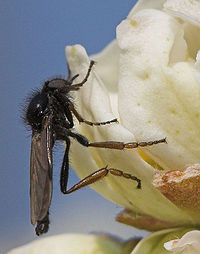- Bibionidae
-
- "March fly" redirects here. In Australia, this term refers to the horse-flies, an unrelated dipteran family.
Bibionidae 
Bibio johannis Scientific classification Kingdom: Animalia Phylum: Arthropoda Class: Insecta Order: Diptera Suborder: Nematocera Infraorder: Bibionomorpha Superfamily: Bibionoidea Family: Bibionidae Genera - Bibio Geoffroy, 1762
- Bibiodes Coquillett, 1904
- Bibionellus Edwards, 1935
- Clothonopsis (fossil, dubious taxon)
- Dilophus Meigen, 1803
- Enicoscolus Hardy, 1961
- Fushunoplecia(fossil)
- Hesperinus Walker, 1848
- Heteroplecia Hardy, 1950
- Lithosomyia (fossil)
- Mesopleciella (fossil)
- Penthetria Meigen, 1803
- Plecia Wiedemann, 1828
Bibionidae (march flies and lovebugs) is a family of flies (Diptera). Approximately 650-700 species are known worldwide.
Contents
Biology
Bibionid larvae grow up in grassy areas and are herbivores and scavengers feeding on dead vegetation or living plant roots. Some species are found in compost (Hardy, 1981). Adults of Plecia and some species of Bibio do not eat, but subsist solely on the food taken in during the larval stage. Adult stage bibionids are quite short-lived, and some species of Plecia (lovebugs) spend much of their adult lifetime copulating. The slow-flying male and female attach themselves at the rear of the abdomen and remain that way at all times, even in flight. Adults swarm after synchronous emergence, sometimes in enormous numbers.
See also detail under Lovebug
Fossil record
Bibionids have the most extensive fossil record of any Diptera family. Fossil bibionids are known questionably from the Jurassic, while some forms from the early part of the Upper Cretaceous look quite similar to modern species. Bibionid flies are very abundant among insect fossils from the Tertiary period, and a large number of species have been described, although often based on highly fragmentary material. Most fossil species are easily identified with extant genera. In particular, the genera Plecia and Bibio are abundant among Tertiary fossils. Fossils from Europe include a large number of specimens of the mainly tropical genus Plecia which is today entirely absent from Europe, demonstrating a warmer climate during the Tertiary.
Economic Importance
Adults are important pollinators. Some larvae are serious plant pests, especially of grassland and other agronomic crops including vegetables (Hardy 1981; Darvas et al. 2000).[1]
Literature (identification)
- ^ Freeman, Paul; Lane, Richard P. (1985) (Print). Bibionid and Scatopsid flies, Diptera: Bibionidae & Scatopsidae. Handbooks for the identification of British insects. 9. London: Royal Entomological Society of London. pp. 74.
- Hardy, D.E. et al., 1958. Guide of the insects of Connecticut PartVI. The Diptera or true flies of Connecticut Sixth Fascicle: March flies and gall midges. Bibionidae, Itonididae (Cecidomiidae). Conn. Geol. Nat. Hist. Surv. Bull. 87, 218 pp., 15 pl., 29 figs.
- Hardy, D.E. ,1967. The Bibionidae (Diptera) of Nepal, results of the Austrian and the B.P. Bishop Museum.Expeditions, 1961 and 1965. Pacific Insects 9(3): 519–536.
- Hardy, D.E. and Delfinado, M.D,1969. The Bibionidae (Diptera) of the Philippines. Pacific Insects 11(1): 117–154.
Gallery
Species Lists
Images
External links
- Plecia nearctica, lovebug on the UF / IFAS Featured Creatures Web site
Categories:- Insect families
- Bibionidae
Wikimedia Foundation. 2010.



